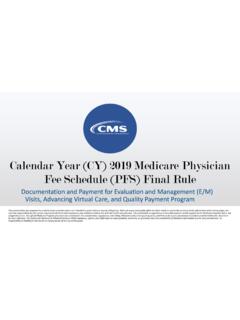Transcription of MEASURES MANAGEMENT SYSTEM - Centers for Medicare ...
1 Centers for Medicare & Medicaid | Measure MANAGEMENT & You | [October 2018] MEASURES MANAGEMENT SYSTEM A Brief Overview of Qualified Clinical Data Registries (QCDRs) A Qualified Clinical Data Registry (QCDR) is a Centers for Medicare & Medicaid Services (CMS) approved vendor that is in the business of improving health care quality. These organizations may include specialty societies, regional health collaboratives, large health systems or software vendors working in collaboration with one of these medical entities. One of the ways QCDRs can help to improve the quality of care patients receive is by collecting clinical data from clinicians and reporting this data to CMS on their behalf for purposes of MIPS. QCDR submission differs from qualified registry submission in that QCDRs can submit non-MIPS MEASURES , called QCDR MEASURES , as well as MIPS quality MEASURES .
2 They may also submit data for the promoting interoperability and Improvement Activities on behalf of the clinician(s). QCDRs must submit data through one of the secure submission methods - in either the Quality Reporting Document Architecture (QRDA) Category III or an approved Quality Payment Program (QPP) JSON or XML format. QCDRs can develop and/or submit MEASURES to CMS for CMS approval and these MEASURES are called QCDR MEASURES . A QCDR may submit no more than 30 approved or provisionally approved QCDR MEASURES for a clinician. QCDRs may submit MEASURES for CMS approval that are: Not contained in the annual list of Quality Payment Program (QPP) MEASURES Have substantive differences in the population covered by an existing QPP measure Have a different manner of submission of an existing QPP measure Developed by the QCDR, specialty societies, or regional quality collaboratives A National Quality Forum-endorsed measure that is not part of MIPS.
3 QCDRs are also permitted to customize the Clinician and Group Consumer Assessment of Healthcare Providers and Systems (CAHPS) and may include non- Medicare beneficiaries. QCDR MEASURES are to be developed in accordance with the Blueprint, but do not need to go through the Pre-Rulemaking process. QCDR MEASURES are submitted as part of the self-nomination process and must be reapproved each year. CMS is willing to meet with QCDRs to review measure concepts prior to self-nomination. MEASURES submitted by QCDRs may be approved, provisionally approved, or rejected. Provisionally approved MEASURES may require revisions, harmonization, or performance data submission for the next year s approval. CMS provides a rationale for the provisional status.
4 Rejected MEASURES will not be re-considered unless the measure has been revised or there is evidence of a performance gap. QCDRs are encouraged to share and/or harmonize similar MEASURES unless there is a compelling reason not to do so. Harmonization between QCDRs provides clinicians with a larger cohort for comparison for performance scoring and benchmarking. Centers for Medicare & Medicaid | Measure MANAGEMENT & You | [October 2018] MEASURES MANAGEMENT SYSTEM A suggested timeline for the QCDR measure process* 1 2 3 4 5 6 7 8 QCDR s create and collaborate to develop and test QCDR MEASURES (Ongoing process) CMS publishes QCDR vendor requirements and QCDR measure requirements/ handbook QCDR submits self-nomination and proposed QCDR measure CMS determines if QCDR entities are eligible to submit QCDR MEASURES on behalf of eligible clinicians CMS determines if the proposed measure is approved, provisionally approved, or rejected for performance period QCDR MEASURES have opportunity for reconsideration, edits/updates QCDR measure specification files are finalized CMS publishes the QCDR measure specification file Annually, CMS puts out a call for QCDR self-nomination.
5 The 2019 Self-Nomination Toolkit for QCDRs and qualified registries is now available. The Toolkit contains the: 2019 Self-Nomination QCDR MEASURES Submission Template QCDR Measure Development for MIPS Program webinar from June 14, 2018 2019 MIPS QCDR Self-Nomination Fact Sheet 2019 QCDR Measure Development Handbook 2019 MIPS Self-Nomination User Guide for QCDRs and Qualified Registries QCDRs must self-nominate annually, even if previously approved. Beginning with the 2019 self-nomination, CMS has simplified the process for existing QCDRs in good standing. CMS may require performance rate data on QCDR MEASURES approved in a previous year to show a continued performance gap. The 2019 self-nomination period opened September 1st and closes November 1st.
6 Self-nomination is completed online using the Office of the National Coordinator for Health Information Technology (ONC) JIRA tracking tool. All information must be provided at the time of self-nomination. There are several benefits of using a QCDR. Here are just a few examples: Because many QCDRs are specialty-based, QCDR MEASURES may be more meaningful and applicable to the eligible clinician. QCDRs streamline data collection and manage the submission of three MIPS categories to CMS. Eligible clinicians may be able to earn bonus credit in multiple performance categories. The clinicians receive benchmark information, so they can see how they are performing on comparison with their peers. QCDRs are required to provide quarterly feedback reports to their participating clinicians, which provides the clinicians the opportunity to make more rapid changes to improve quality of care.
7 * Example from General Dynamics Information Technology












